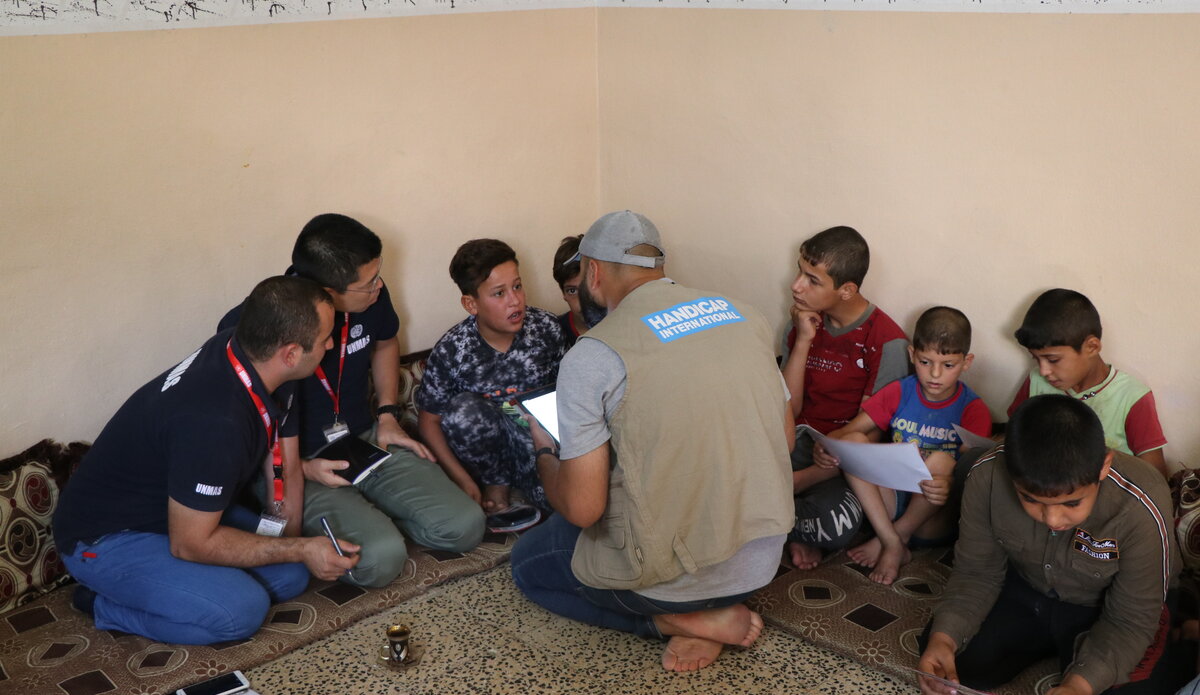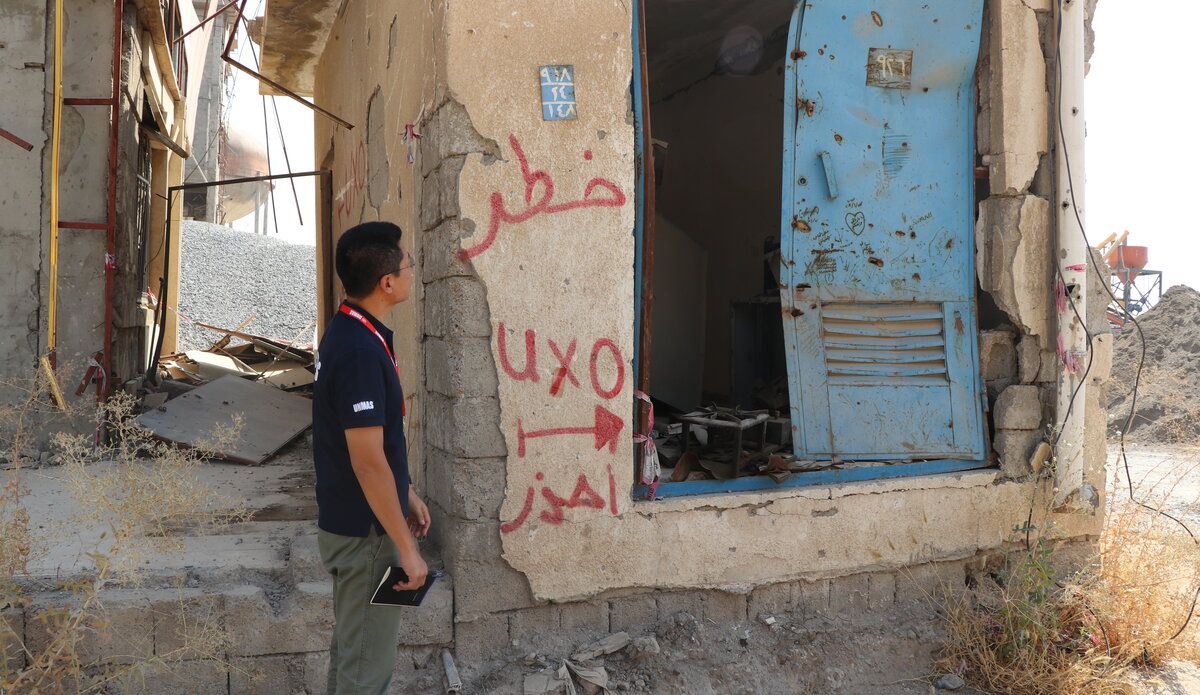BAGHDAD — Japan has earned the well-deserved respect of the world, emerging from conflict to become an economic success at home and a strong proponent of socially responsible policies and actions both at home and abroad.
I am a beneficiary of both Japan’s economic success and social conscience, working for an outcome, a safe home for all, but particularly for the remaining 1.6 million internally displaced persons (IDP) in Iraq. Many are still living in camps nearly two years after Iraqi Security Forces evicted Islamic State fighters from west Mosul, site of the militant group’s ill-fated “last stand.”
When will the IDPs finally return home? That depends on the pace of clearance of explosive hazards, the critical first step toward a safe home for all, which depends, in turn, upon the continued generosity of countries like my own. Japan has contributed more than ¥432 million, principally to risk education programs of the United Nations Mine Action Service (UNMAS). Last year alone, Japan provided an overall total of ¥6.8 billion for Iraq, which should come as no surprise. What do friends do in times of trouble? They help one another.
Japan and Iraq have long been friends. This year the two countries will celebrate 80 years of diplomatic relations. Sure, trade and investment depend upon political stability, so they remain incentives, but social conscience and historical perspective count, too.
Certainly, my exposure here to Iraq’s situation has had a profound effect on me as I think it would have on any Japanese, particularly after a visit to west Mosul. The former capital of the IS caliphate for the most part still lies in ruins.
Mosul is a city divided by the Tigris River. The east side is new, the west side is ancient and as important to Iraqi culture as Kyoto is to Japanese culture. Think of Kyoto as simply gone and what it would mean to us to walk through deserted, debris-filled streets, past collapsed houses, destroyed buildings, desecrated temples and broken monuments.
In west Mosul today, we continue to find the remains of those fighters killed before they could detonate their suicide belts and their innocent hostages often wearing belts, too, interned together by the hundreds under nearly 7 million tons of debris, along with a random mix of unexploded remnants of war.
Most worrisome are the improvised explosive devices (IEDs) hidden under the debris, concealed in building walls, in collapsed homes in air-conditioning units and refrigerators, some triggered by ingenious infrared devices undergarments hanging on pegs, others attached to abandoned toys in playgrounds waiting for a child’s touch. As of Jan. 30, 2019, UNMAS operators had completed nearly 1,100 IED tasks in Mosul alone.
IEDs are the IS way of continuing its battle in absentia and “on the cheap,” threatening to maim or kill indiscriminately the young and old, daughters and sons, husbands and wives, anyone who puts one foot wrong, including the members of our own clearance teams.
IS remains a menacing presence throughout Iraq’s so-called liberated area approximately one-third the size of Japan. A recent Iraqi Security Forces counterinsurgency operation involving a ground force of 30,000, plus air force units, targeting IS cells across 100,000 sq. km. in northern and western Iraq is a statement in itself of Islamic State’s resilience and resurgence.
IS was never really defeated. Their fighters simply disappeared, hiding sometimes in plain sight among sympathizers, sometimes in tunnels. As reported in news media accounts, IS fighters emerge daily from their hiding places to attack city markets, to burn farmers’ crops, to intimidate, extort and to harass the local population and worse. Their plan is simple: “Destabilize” the economic and social order, erode public trust and confidence in government and create havoc until they can again resume control, however long it takes.
Arguably, rebuilding cities like Mosul and restoring the countryside also deprives IS of a propaganda win. Granted, stable communities and jobs alone may not be enough to defeat an ideology, blamed for the alienation of many in a generation responsible for the conflict and the devastation in the first place. But with no “safe home” to return to, displaced persons and refugees alike will remain the exploited hostages of an unseen enemy, a humanitarian burden and cost to the international community.
The United Nations estimates the cost of its humanitarian response plan for Iraq in 2019 at $701 million. Worst of all, denied their human dignity, inhumane conditions and lack of opportunity lead to further alienation, perpetuating another round of recruits followed by another. We can calculate the human toll in other ways. For example, according to the U.N., in Duhok’s 12 IDP camps alone, of 40 suicide attempts in 2018, 22 resulted in death.
Although we don’t have a precise way to calculate amounts of explosive hazards remaining, time to complete clearance tasks and associated costs, we do have an idea of what violence as a whole costs Iraq. According to the Sydney-based Institute for Economics & Peace, violence and conflict in 2015 cost Iraq the equivalent of 53.5 per cent of its current gross domestic product (GDP) or $206 billion annually. Conversely, eliminate violence and conflict, the reciprocal of that amount logically accrues to Iraq as a “peace dividend,” which brings us full circle to the argument for “clearance first.”
From the start of operations in August 2016 through the end of April 2019, UNMAS Iraq teams cleared more than 31,000 explosive remnants of war, including more than 2,200 IEDs including suicide vests, surveyed an area exceeding more than 182 million sq. meters, and cleared more than 4.8 million sq. meters of explosive hazards, in addition to conducting risk education for those seeking a safe return home, as well as training local authorities to respond to threats.
The clearance leads to stabilization projects and lives and livelihoods restored.
In east Mosul, following clearance, the now repaired Al Qasoor Water Treatment Plant again supplies clean and safe water to more than 300,000 people across 34 service areas.
In Ninewa Province, following clearance, the High Court offers access deeds to validate land claims of residents seeking return.
In Jadidah, following clearance of the fuel station, its 20 employees, after a three-year hiatus, pump fuel for more than 300 vehicles daily.
In Fallujah, two months after UNMAS divers safely removed and disposed of two submerged IEDs from the “Iron Bridge,” what had been a two-hour detour for some patients to reach the region’s only maternity hospital is, once again, a five-minute trip; and an asphalt factory, reopened after four years, when operating at full capacity, will employ 65 workers, supporting 350 people, produce 500 to 700 tons of asphalt daily, enough to surface 4,000 sq. meters of road.
In rural areas, with a village well cleared of IEDs, 50-plus rural families in Al Bokald near west Mosul again have access to water to grow their crops.
In west Mosul, we see positive gains once areas and infrastructure are cleared of hazards, often with an interesting pattern. People invest their own money sans government programs to open a small shop, to plaster and paint buildings, often with one thing in common: The neighbourhood school has been cleared and rebuilt even if water or electricity has yet to be restored as if to say children come before the most basic of needs.
Yet, even after a dignified, voluntary return to a “safe home,” people can remain at risk for the reason that neighbourhoods remain dangerous.
To protect these “at risk’ groups, UNMAS Risk Education programs, supported by Japan, have blanketed those living in neighbourhoods who may still be exposed to explosive hazards and those in IDP camps. Creative approaches have introduced self-protective measures and behaviour, reaching more than 500,000 girls and boys, men and women, young and old in 2018 alone. If they drank water or ate dates during Ramadan, the chances are they noticed the same, life-saving messages as public service “advertising” on bottles of water and boxes of dates courtesy of UNMAS: what to look for, what not to touch, who to notify. That effort, with Japan’s generous support, continues.
What Iraq needs now are steadfast friends like Japan and their continued support. Why? Iraq is poised to recover its status as a stable, middle-income country in a still volatile the Middle East. Arguably, rebuilding cities like Mosul and restoring the countryside also deprives IS of a propaganda win.
So long as there is contamination present, IS can continue to wage low intensity, but very real, asymmetric conflict, emerging from the shadows at will to kill and kidnap, extending the costly efforts to subdue and eliminate their presence and their influence. Therefore, the strategy to create conditions to resettle displaced persons and attract “returnees” from abroad, already validated by progress to date, should continue and deserves support to finish the job.
We will know when that day arrives. All will have the safe home they deserve, will be able to walk their streets in safety, to visit the Al-Nouri mosque if they like, the same as any Japanese might pause at the Kiyomizudera temple on a pleasant day.
Mashima is a program officer based in Baghdad with the United Nations Mine Action Service (UNMAS). The opinions expressed in this article are his own and do not necessarily reflect those of UNMAS or the United Nations.
By Shinobu Mashima / Special to The Yomiuri Shimbun
The article was originally published in The Japan News on 21 September 2019


